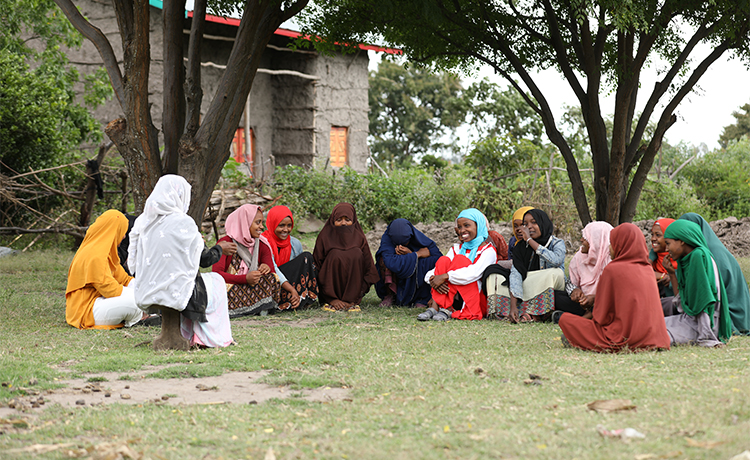DALOCHA DISTRICT, Ethiopia – When she was fourteen, Zekia discovered that her parents were secretly preparing for her older sister to undergo female genital mutilation.
“My brother heard about it and tried to discourage them,” she told UNFPA, the United Nations sexual and reproductive health agency. “He reminded them that the practice has been prohibited and argued it would expose my sister to lots of complications.”
Zekia had witnessed at first-hand the pain the procedure can cause. “I always cite the difficulties my niece went through when she gave birth.”
Female genital mutilation is an act of gender-based violence and an internationally recognized violation of human rights. It can lead to multiple serious conditions, including obstetric fistula from obstructed labour, infections, heavy bleeding, psychological trauma, and even death.
When her parents refused to listen to her brother, he reported the case to the local authorities. For generations, their community has been committed to what had been held up as a tradition; but a new series of bylaws and awareness campaigns are chipping away at this notion – and galvanizing young people like Zekia to lobby against it.
UNFPA estimates that globally in 2024, nearly 4.4 million girls – more than 12,000 a day – are at risk of being subjected to female genital mutilation. The procedure not only causes physical and mental harm, but many girls lose weeks of schooling as they recover, with countless more never returning at all. This limits their academic and workforce potential, blunting their earning power and weighing the scales of justice even more heavily against them.

A brighter future for young girls
Luckily for Zekia’s sister, she wasn’t one of them: The local authorities intervened and stopped the ritual from taking place, saving both sisters and making them among the first in their community not to be subjected to the practice.
Although they weren’t stigmatized by family or friends, it was not an easy experience for the girls. But as an active advocate against female genital mutilation, Zekia used her knowledge to raise awareness about the dangers among others across her district.
“Members of my community have begun to follow suit, sparing their daughters from it.”
Thanks largely to grassroots, survivor-led movements in countries around the world, girls today are around one third less likely to be subjected to the practice than they were 30 years ago.
Zekia said discussions with her fellow classmates and female teachers are also key to overturning acceptance. “None of the girls in my school and age group have been [subjected to it] as a result,” she told UNFPA.
And she doesn’t stop there. “I talk about the harms in places where women gather, such as at water points, flour mills and market places,” she said, adding that men and boys also join some of the discussions.
Many of the survivors Zekia has met are now advocating against it, as well as against other human rights violations like child marriage, which is common in the region.
It’s another trend Zekia and her sisters are determined to buck. “Although she is over 18, my sister has not got married yet as she wants to finish high school. This would have been unthinkable just a few years ago,” she said.
“And I am determined to pursue my studies too and become a doctor one day.

A multisector effort
The UNFPA-UNICEF Joint Programme works in 17 countries to eliminate female genital mutilation and has launched initiatives across four districts in Ethiopia’s Central region. Dalocha has one of the highest rates of the practice in Ethiopia, with almost 76 per cent of women and girls aged 15 to 49 subjected to it in 2000; by 2016, this had dropped to just over 60 per cent.
As of last year, the Joint Programme supported more than 11,000 groups working against female genital mutilation globally, of which 83 per cent were local organizations partnering with survivor-led movements and advocating for legal, political and – perhaps most crucially – societal change.
One of these groups is the regional Bureau of Women’s and Children’s Affairs, which fights harmful practices together with the health and education sectors and law enforcement bodies. Nuritu Sirbar is the head of the bureau, and explained how influential members of the community, including religious leaders and ex-practitioners, have rallied to the cause.
“There is progress,” Ms Sirbar said. “Now we register all the girls at preschool and work with their parents to make sure they don’t go through it.” She’s also working with youth groups and schools, raising awareness among boys and young men as well.
“I thought I knew why we enforced female genital mutilation,” said Simrimula Hamiza, an elder in the community. “But when asked at a meeting, I just didn’t have a good enough answer… For the first time, I realized that we can't defend the practice by simply saying it’s a tradition. Young people ask why and look for an answer in science, not in the old tales.”
And although it may take some time for a new generation to fully emerge, “there is change in the air,” added Ms Sirbar.


